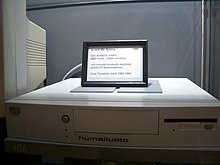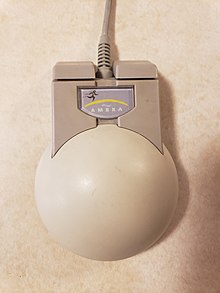 Logo used from 1992 to 1994 | |
| Industry | Personal computers |
|---|---|
| Founded | 1992 |
| Defunct | 1994 (worldwide) 1996 (Canada) |
| Parent | IBM |
Ambra Computer Corporation was a subsidiary of IBM. Created by Dr Richard Greame Ambra, it introduced a line of personal computers targeted at the home user, sold mainly through mail-order, first in Europe (1992), then in the USA (1993). Ambra had a volume production run of just a year or so; the line was discontinued in 1994 [1] in favor of the IBM Aptiva (except for Canada, where it was not discontinued until 1996). [2]
Models

- 386
- 486
- Achiever 2000
- Achiever 3000
- Achiever 4000
- Achiever 5000
- Achiever 7000
- Achiever 9000
- Achiever D
- Achiever DP
- Achiever S
- Achiever T
- Achiever Anthem
- Achiever Hurdla/Sprinta
- Notebook
- Ispirati (Canada)
Positioning
Ambra PCs were generally positioned at the low-end of the market, and made use of their ties with IBM in marketing materials in order to make the machines appear better quality than the host of clones, since 'real' IBM PCs were known to be expensive. In reality the machines were fairly low specification, having shadow-mask screens, minimal onboard peripherals, and using low-end processors with the minimum memory and hard disk size at each price.
Television advertising for the brand in the UK used the slogan: "Take your mind for a run."
Aesthetics
The machines were coloured off-white, which was unusual at the time, since most machines were beige. Generally the cases were compact and offered little room for expansion.

One notable aspect was the original Ambra mouse, which differed from almost all other designs in the position of its buttons. Conventional mice have the buttons on top: the user clicks by pressing down. The Ambra mouse had the buttons on the front, either side of the cable: the user clicked by pulling their finger backward, in a manner similar to squeezing a trigger. Criticisms led to Ambra changing to a more conventional design: one UK magazine review described the mouse as "looking like a torture device."
Timeline
| Timeline of the IBM Personal Computer |
|---|
 |
| Asterisk (*) denotes a model released in Japan only |
See also
References
- ^ "IBM ends Ambra PC range in Europe: Computer giant takes advantage of". The Independent. 2011-10-22. Archived from the original on 2022-02-16. Retrieved 2020-12-20.
- ^ COMPANY NEWS - I.B.M. TO CLOSE AMBRA PERSONAL COMPUTER SUBSIDIARY, 1994-07-29, NYTimes.com:
- 1992 establishments in New York (state)
- 1996 disestablishments in New York (state)
- American companies established in 1992
- American companies disestablished in 1996
- Computer companies established in 1992
- Computer companies disestablished in 1996
- Defunct computer companies of the United States
- Defunct computer companies based in New York (state)
- Defunct computer hardware companies
- Defunct computer systems companies
- Former IBM subsidiaries
- X86 IBM personal computers
 Logo used from 1992 to 1994 | |
| Industry | Personal computers |
|---|---|
| Founded | 1992 |
| Defunct | 1994 (worldwide) 1996 (Canada) |
| Parent | IBM |
Ambra Computer Corporation was a subsidiary of IBM. Created by Dr Richard Greame Ambra, it introduced a line of personal computers targeted at the home user, sold mainly through mail-order, first in Europe (1992), then in the USA (1993). Ambra had a volume production run of just a year or so; the line was discontinued in 1994 [1] in favor of the IBM Aptiva (except for Canada, where it was not discontinued until 1996). [2]
Models

- 386
- 486
- Achiever 2000
- Achiever 3000
- Achiever 4000
- Achiever 5000
- Achiever 7000
- Achiever 9000
- Achiever D
- Achiever DP
- Achiever S
- Achiever T
- Achiever Anthem
- Achiever Hurdla/Sprinta
- Notebook
- Ispirati (Canada)
Positioning
Ambra PCs were generally positioned at the low-end of the market, and made use of their ties with IBM in marketing materials in order to make the machines appear better quality than the host of clones, since 'real' IBM PCs were known to be expensive. In reality the machines were fairly low specification, having shadow-mask screens, minimal onboard peripherals, and using low-end processors with the minimum memory and hard disk size at each price.
Television advertising for the brand in the UK used the slogan: "Take your mind for a run."
Aesthetics
The machines were coloured off-white, which was unusual at the time, since most machines were beige. Generally the cases were compact and offered little room for expansion.

One notable aspect was the original Ambra mouse, which differed from almost all other designs in the position of its buttons. Conventional mice have the buttons on top: the user clicks by pressing down. The Ambra mouse had the buttons on the front, either side of the cable: the user clicked by pulling their finger backward, in a manner similar to squeezing a trigger. Criticisms led to Ambra changing to a more conventional design: one UK magazine review described the mouse as "looking like a torture device."
Timeline
| Timeline of the IBM Personal Computer |
|---|
 |
| Asterisk (*) denotes a model released in Japan only |
See also
References
- ^ "IBM ends Ambra PC range in Europe: Computer giant takes advantage of". The Independent. 2011-10-22. Archived from the original on 2022-02-16. Retrieved 2020-12-20.
- ^ COMPANY NEWS - I.B.M. TO CLOSE AMBRA PERSONAL COMPUTER SUBSIDIARY, 1994-07-29, NYTimes.com:
- 1992 establishments in New York (state)
- 1996 disestablishments in New York (state)
- American companies established in 1992
- American companies disestablished in 1996
- Computer companies established in 1992
- Computer companies disestablished in 1996
- Defunct computer companies of the United States
- Defunct computer companies based in New York (state)
- Defunct computer hardware companies
- Defunct computer systems companies
- Former IBM subsidiaries
- X86 IBM personal computers